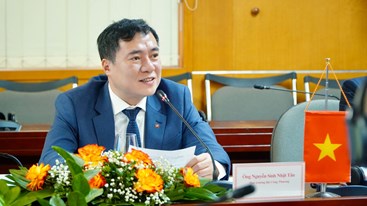Wednesday, 24/04/2024 | 01:56 GMT+7
While in general terms wind energy does not represent a
threat to wildlife, poorly sited or designed wind farms can have a negative
impact on vulnerable species and habitats That's why the European Commission
has published today guidelines for wind energy development in protected natural
areas. The guidelines apply to the Natura 2000 network, a cornerstone of EU
biodiversity policy and a key tool to achieve the EU target of halting and
reversing biodiversity loss by 2020.

Wind energy has an important role to play in meeting the EU target of 20% renewable energy in Europe's total energy consumption by 2020, and its deployment in Natura 2000 areas is not automatically excluded. But such developments need to be evaluated on a case by case basis. Janez Potočnik, European Commissioner for the Environment said: "These new guidelines will give Member States and industry clarity regarding the undertaking of wind energy development activities in accordance with Natura 2000 requirements. There is no change of legislation or policy, but merely guidance on existing law. Our aim is to ensure that renewable energy targets are met while fully respecting EU law on species protection."
Strategic planning is key
The guidelines published today are aimed at avoiding conflict between wind energy development and biodiversity conservation in Natura 2000 protected areas. They highlight the importance of strategic planning and the need for good quality appropriate assessment of new developments. The guidelines contain examples of best practice, and show how wind energy developments can avoid damage to nature sensitive areas. Planning wind farm developments in a strategic manner over a broad geographical area is one of the most effective means of minimising the impacts of wind farms on nature and wildlife from the start of the planning process. It not only leads to a more integrated development framework but should also reduce the risk of difficulties and delays at later stages at the level of individual projects.
Background
Europe has set itself a target of obtaining 20% of its energy consumption from renewable sources by 2020, and wind energy is destined to make a significant contribution to achieving that goal. Wind energy also helps to substantially reduce greenhouse gas and air pollutant emissions, as well as freshwater consumption associated with conventional power generation in the EU. Wind energy has grown rapidly over the last decade, and in 2009 it accounted for some 4.8% of the EU's total electricity consumption. This is expected to at least triple by 2020.
Natura 2000 is an EU-wide ecological network of nearly 26 000 sites in the 27 EU countries, established under the 1992 Habitats Directive and covering almost 18% of the EU's land area. The aim of the network is to assure the conservation and sustainable use of areas of high biodiversity value and long-term survival of Europe's most valuable and threatened species and habitats. Natura 2000 is not a system of strict nature reserves where all human activities are excluded. Whereas the network will certainly include nature reserves, most of the land is likely to continue to be privately-owned and the emphasis will be on ensuring that future management is sustainable, both ecologically and economically.
energyportal.eu








.jpg?w=367&h=206&mode=crop) Energy efficiency and conservation usage is an important aspect of the national energy development strategy
05/03/2024
Energy efficiency and conservation usage is an important aspect of the national energy development strategy
05/03/2024
 Vietnam - Denmark promote cooperation in the energy sector
Vietnam - Denmark promote cooperation in the energy sector
 Challenges and Opportunities to promote energy efficiency market in Vietnam
Challenges and Opportunities to promote energy efficiency market in Vietnam
 The Ministry of Industry and Trade requests government agencies to coordinate in organizing Earth Hour 2024
The Ministry of Industry and Trade requests government agencies to coordinate in organizing Earth Hour 2024
 Consultation on Energy Efficiency Boiler Catalogue and Wood Drying Guideline
Consultation on Energy Efficiency Boiler Catalogue and Wood Drying Guideline
 Son Ha Co., Ltd, applies energy efficiency and conservation measures
Son Ha Co., Ltd, applies energy efficiency and conservation measures
 Phuc Kien Co., Ltd., is effectively implementing energy-saving measures
Phuc Kien Co., Ltd., is effectively implementing energy-saving measures
.png?w=367&h=206&mode=crop) Request for expression of interest - C2.1.13: Capacity Building on energy efficiency policies development
Request for expression of interest - C2.1.13: Capacity Building on energy efficiency policies development